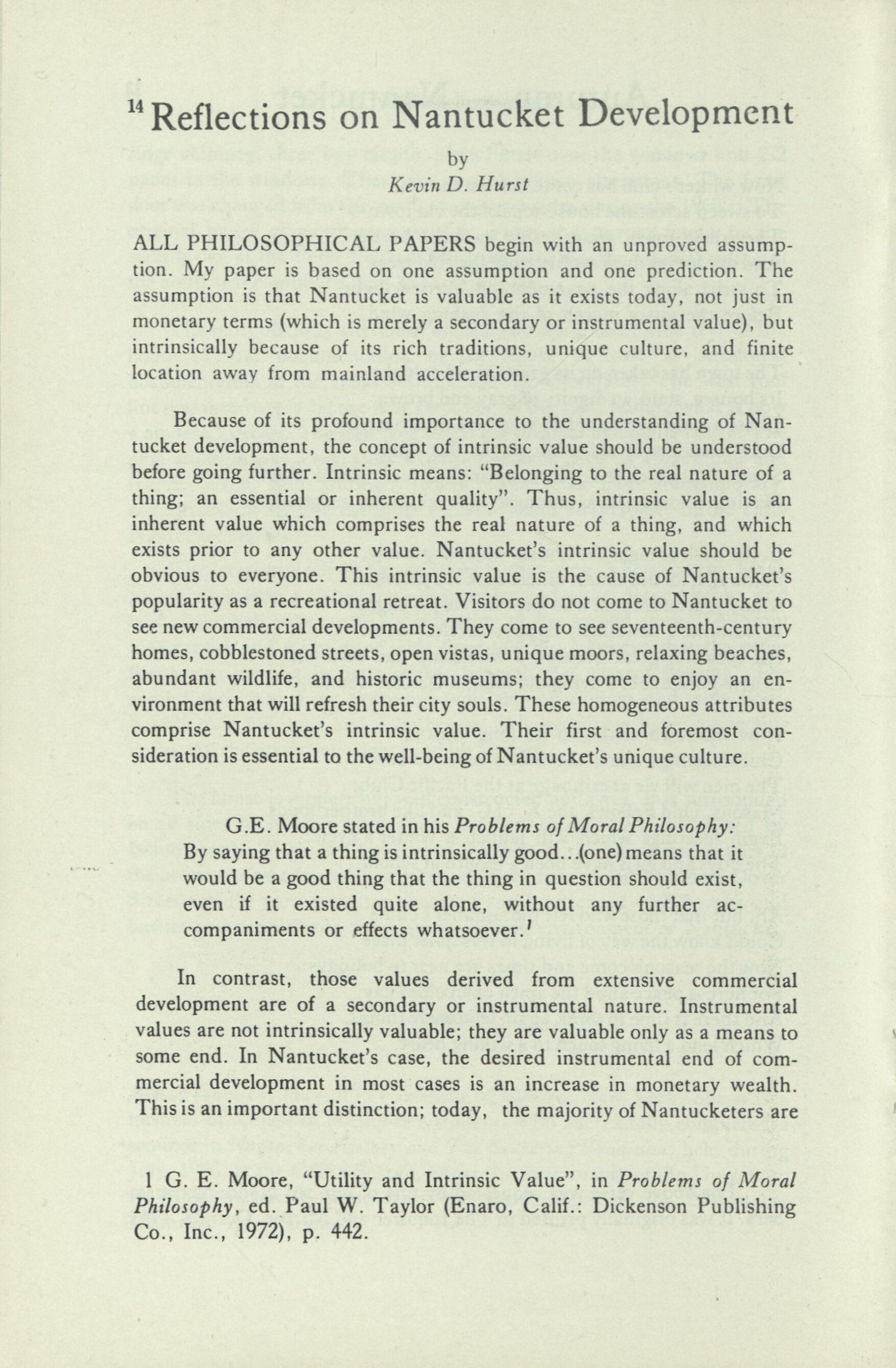
20 minute read
by Kevin Hurst
1 4 R e fl ec t io n s o n N a n t u c k et D e v e lo p men t
by Kevin D. Hurst
ALL PHILOSOPHICAL PAPERS begin with an unproved assumption. My paper is based on one assumption and one prediction. The assumption is that Nantucket is valuable as it exists today, not just in monetary terms (which is merely a secondary or instrumental value), but intrinsically because of its rich traditions, unique culture, and finite location away from mainland acceleration.
Because of its profound importance to the understanding of Nantucket development, the concept of intrinsic value should be understood before going further. Intrinsic means: "Belonging to the real nature of a thing; an essential or inherent quality". Thus, intrinsic value is an inherent value which comprises the real nature of a thing, and which exists prior to any other value. Nantucket's intrinsic value should be obvious to everyone. This intrinsic value is the cause of Nantucket's popularity as a recreational retreat. Visitors do not come to Nantucket to see new commercial developments. They come to see seventeenth-century homes, cobblestoned streets, open vistas, unique moors, relaxing beaches, abundant wildlife, and historic museums; they come to enjoy an environment that will refresh their city souls. These homogeneous attributes comprise Nantucket's intrinsic value. Their first and foremost consideration is essential to the well-being of Nantucket's unique culture.
G.E. Moore stated in his Problems of Moral Philosophy: By saying that a thing is intrinsically good...(one)means that it would be a good thing that the thing in question should exist, even if it existed quite alone, without any further accompaniments or effects whatsoever.'
In contrast, those values derived from extensive commercial development are of a secondary or instrumental nature. Instrumental values are not intrinsically valuable; they are valuable only as a means to some end. In Nantucket's case, the desired instrumental end of commercial development in most cases is an increase in monetary wealth. This is an important distinction; today, the majority of Nantucketers are
1 G. E. Moore, "Utility and Intrinsic Value", in Problems of Moral Philosophy, ed. Paul W. Taylor (Enaro, Calif.: Dickenson Publishing Co., Inc., 1972), p. 442.
Reflections on Nantucket 15
treating the instrumental values derived from development as intrinsic values when, in fact, they are not. These instrumental values are totally dependent on the well-being of Nantucket's intrinsic value.
Based on my assumption, my prediction is that unless some sort of stricter regulation is enacted to control Nantucket's future development, this island's unprotected intrinsic value which has taken over three hundred years to accumulate socially, and hundreds of thousands of years to unfold physically, will be lost in the swing of a developer's hammer. I feel Nantucket, viewed as an abstract entity comprising past generations as well as present and future generations, has reached a point in time (and, perhaps is already on the way downhill), where increased commercial and residential development will only lead to a progressive demise of the island's intrinsic value: a value which is at the base of all other value systems, especially the instrumental value system developers and realtors rely on.
There is a paradox involved here: while the value derived from monetary gain increases with further developments (I should add that this value is shared not by everyone, but by only a few), the intrinsic foundation underneath the monetary value system (the intrinsic value, whether realized or not, is shared by all who visit Nantucket), will crumble in relative proportions. From this, one may conclude the harsh realities of my prediction: the prediction, unless realized now, will be proved correct only after the island is already ruined by development.
Resting overdeveloped on crumbled foundations, the island will have lost all its ability to support anything that attempts to be'aesthetically pleasing. People will no longer look at Nantucket as a place to recuperate from the accelerated realities of city life. They will no longer be able to enjoy an historical oasis, whose lighthouse now beckons all to learn from her interesting past:
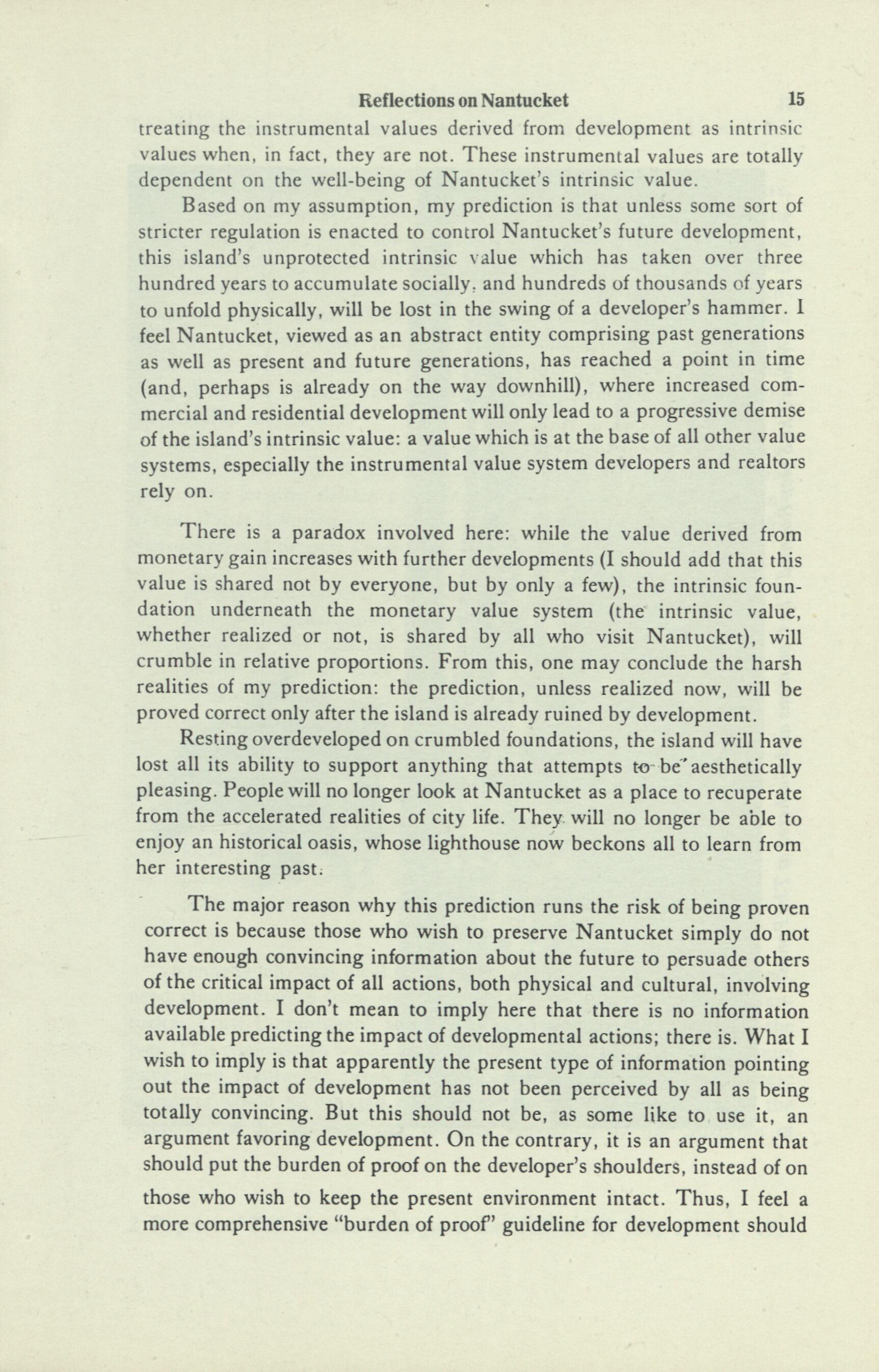
The major reason why this prediction runs the risk of being proven correct is because those who wish to preserve Nantucket simply do not have enough convincing information about the future to persuade others of the critical impact of all actions, both physical and cultural, involving development. I don't mean to imply here that there is no information available predicting the impact of developmental actions; there is. What I wish to imply is that apparently the present type of information pointing out the impact of development has not been perceived by all as being totally convincing. But this should not be, as some like to use it, an argument favoring development. On the contrary, it is an argument that should put the burden of proof on the developer's shoulders, instead of on those who wish to keep the present environment intact. Thus, I feel a more comprehensive "burden of proof' guideline for development should

Reflections on Nantucket 17
be enacted immediately and governed by town officials and concerned citizens.
I hope this paper will help convince people, especially Nantucketers, that by giving a little (by supporting responsible plans for restricting development), they will gain a lot. They will gain the immense satisfaction of living on, or even just visiting, an oasis of history. They will feel contentment when able to say that they helped preserve an endangered species. They will have the enjoyment of knowing that there will still be a place left where their children's children can go to escape the chaotic city life, and learn about freedom and preservation, and other things that can add moral fiber to a society partially crippled by the complexities of city life.
I realize that the words "control" and "regulations" sound abhorrent to most Nantucketers. A perfect example of this indifferent attitude was seen in the lengthy debate over Senator Kennedy's Nantucket Sound Islands Trust Bill, first proposed in 1972. Here was an opportunity for Nantucketers to support a policy which would, in theory:
preserve and conserve such values for the enjoyment of present and future generations, to preserve and conserve the natural ecological environment, and to encourage maximum coordinate action by state and local governments and private individuals, groups, organizations, and associations; all to the end of protecting these values from developments and uses which would destroy the scenic beauty and natural character of the area. In preserving the Nantucket Sound Islands and stabilizing their development, substantial reliance shall be placed upon coordinate action between Federal, State, and local governments to apply sound principles of land use planning and zoning; and full recognition shall be given to protecting private properties for the enjoyment of the owners.2
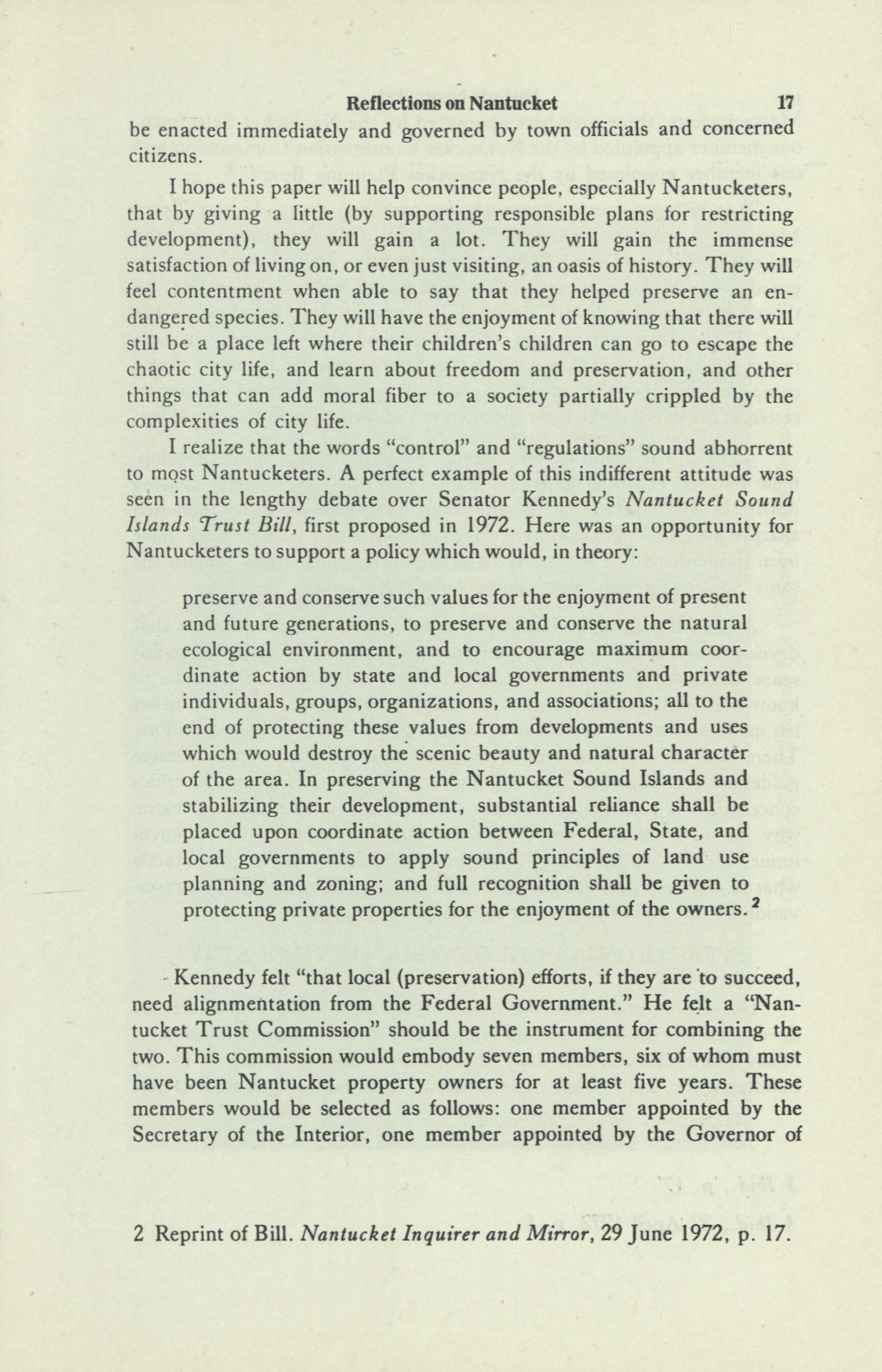
Kennedy felt "that local (preservation) efforts, if they are to succeed, need alignmentation from the Federal Government." He felt a "Nantucket Trust Commission" should be the instrument for combining the two. This commission would embody seven members, six of whom must have been Nantucket property owners for at least five years. These members would be selected as follows: one member appointed by the Secretary of the Interior, one member appointed by the Governor of
2 Reprint of Bill. Nantucket Inquirer and Mirror, 29 June 1972, p. 17.
lg Historic Nantucket
Massachusetts, three members appointed by the Nantucket Selectmen, one member appointed by the Nantucket Conservation Commission and one member appointed by the Nantucket Planning Board. 3
This bill was fought rigorously for over two years. In one Town Meeting, "a voice vote taken by Mr. Gifford (a bill proponent) near the end of the three and one half hour long meeting, showed that those opposed to the bill far outnumbered those in favor". Gifford then asked "for those who wanted a slowing down of developments on the island to say 'aye'. There was a roar of 'ayes' and no one said 'nay'.4 During the next two years, the bill was extensively revised three times in the hope that a compromise might be found. In the end, however, the power of persuasion rested in the hands of the bill's opponents, and it was consequently tabled.
In 1972, the Nantucketers' intentions were to slow down development by local efforts. Eight years later, I don't see development slowing down. In fact, developments and their ramifications have increased sharply since 1972. No comprehensive controls, either local or state, have been implemented. The variety of arguments against them remain the same, and every year brings more haphazard growth.
As a final note before examining some of the specific arguments that developers use to try to justify their cause, I wish to convey my often felt sense of being overwhelmed by ramifications. I should like the reader to know that some of the questions concerning development on Nantucket left me feeling as if I were chasing white rabbits down endless corridors. There are, in my estimation, no easy step-by-step comprehensive guidelines available that can enlighten everyone about the profound ethics concerning Nantucket development. To me, this is all the more reason why we must all pitch in to stop Nantucket's runaway development immediately, in order to buy some time to think out thoroughly exactly what course will produce the most ethical progress towards the preservation of the values that make Nantucket, "Nantucket".
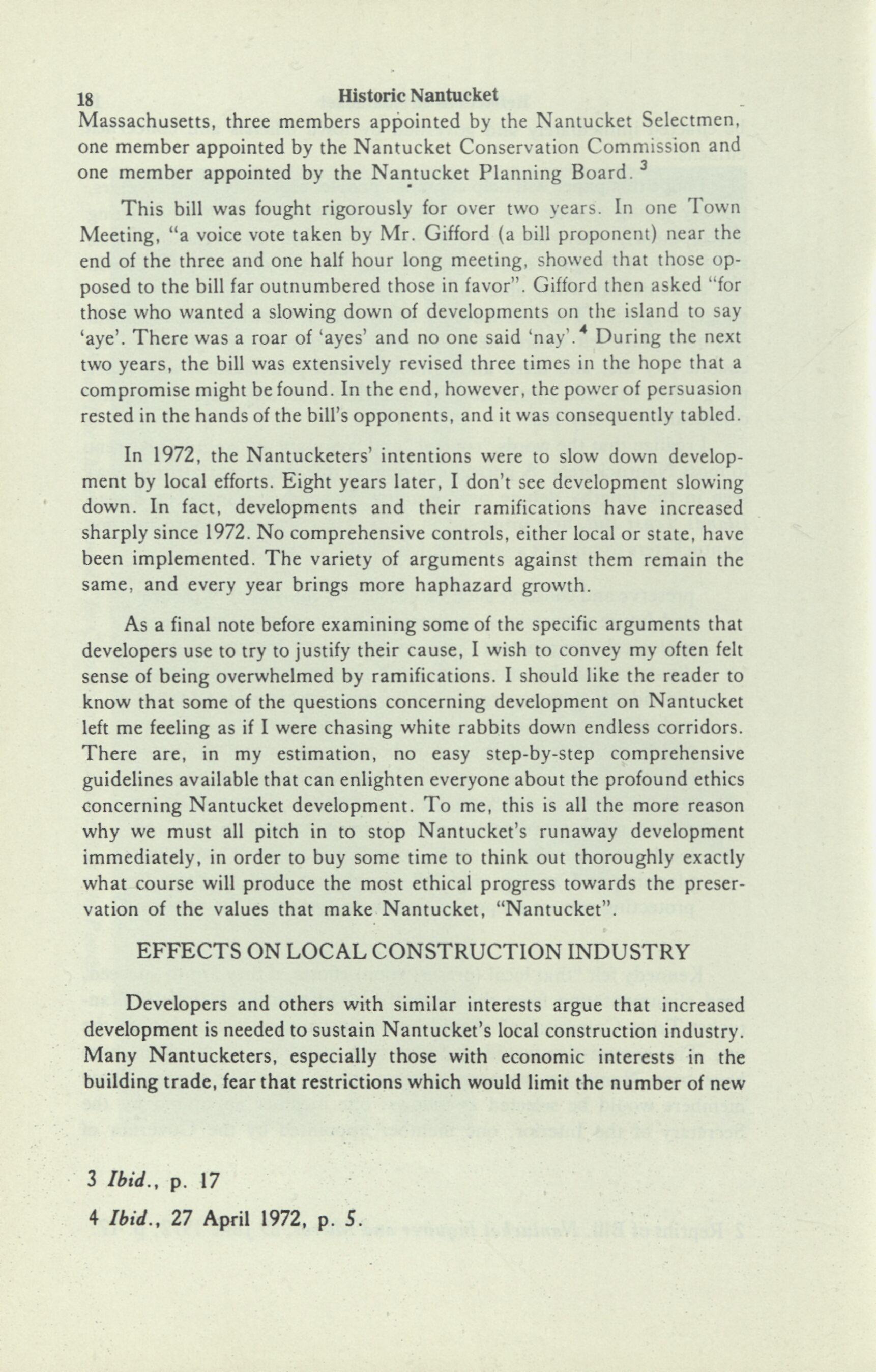
EFFECTS ON LOCAL CONSTRUCTION INDUSTRY
Developers and others with similar interests argue that increased development is needed to sustain Nantucket's local construction industry. Many Nantucketers, especially those with economic interests in the building trade, fear that restrictions which would limit the number of new
3 Ibid., p. 17
4 Ibid., 27 April 1972, p. 5.
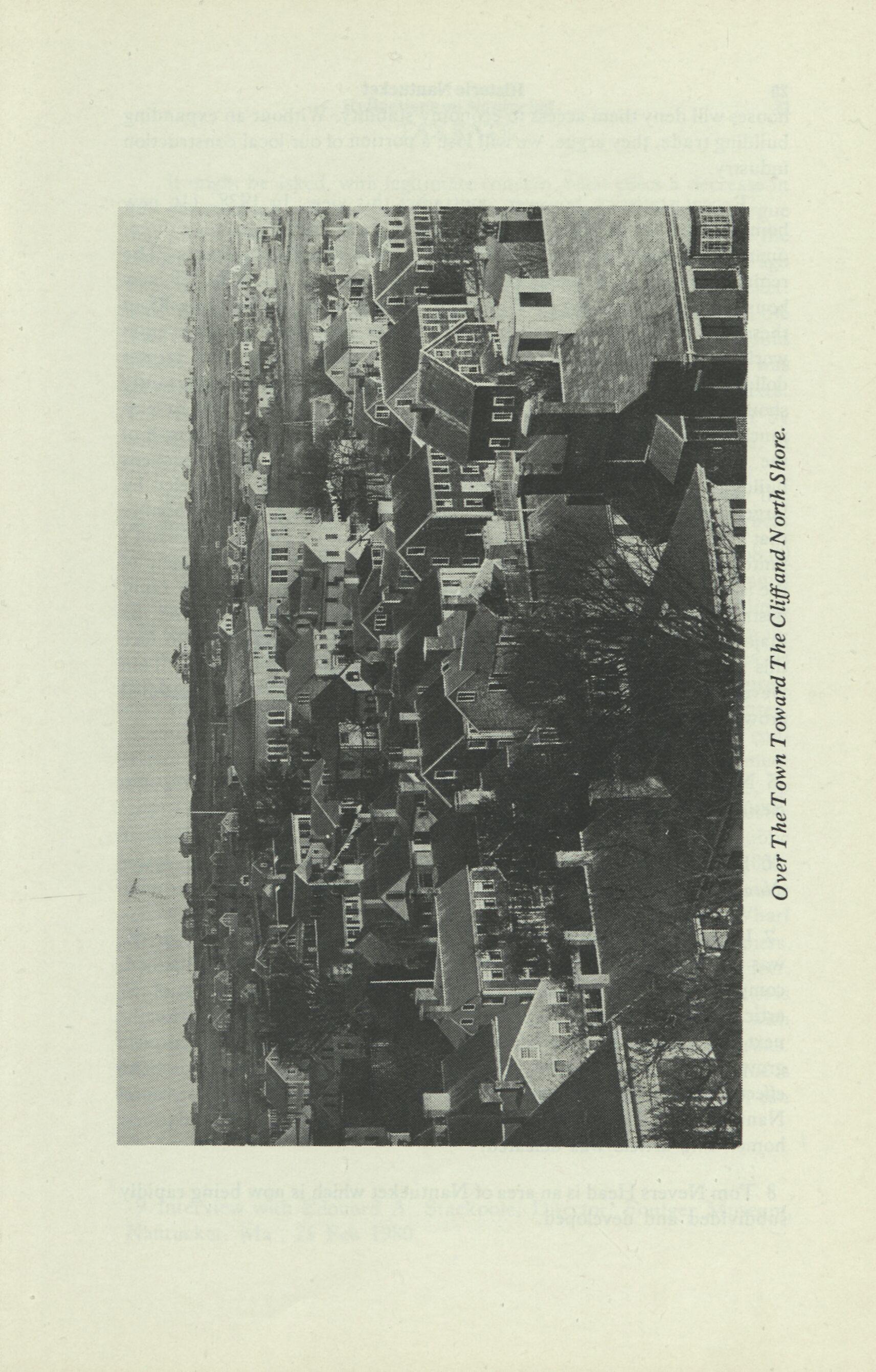
20 Historic Nantucket
houses will deny them access to economy stability. Without an expanding building trade, they argue, we will lose a portion of our local construction industry.
Recent statistics, however, contradict this view. In 1978, 116 new homes were built on Nantucket. Of these 116 new buildings, only threequarters of them were built with the help of island contractors. The remainder were built using off-island contractors.5 In 1979, 159 new houses were constructed (a 97 percent increase over 1976). Only 85 of these new buildings were constructed with the help of local construction workers.6 Thus, the local construction industry (the second largest dollar-making industry on the island) could, and more importantly should, survive on less new construction if the long-range goal is to save as much of the natural environment as possible,and to control the growth of the island in an orderly and comprehensive way. 7 If Nantucket's building trade is not limited, it will grow fast and recklessly. Fueled by larger and larger amounts of new construction, it will soon be a bonfire that can only be extinguished by burning itself out.i. e., when the island's finite area is fully developed. The results of rapid and total development of the island will be: a great deal of money for a few entrepreneurs; a rapid destruction of the island's intrinsic value, and unemployment for the majority of Nantucket's construction workers. My suggestion is to face this future possiblity NOW, not after the gun has gone off, and Tom Nevers Head (among others)8 is reeling from the impact of uncontrolled growth.

6 Public Service Announcement of the Nantucket Land Council. Nantucket Inquirer and Mirror, 28 Feb. 1980.
7 In the April, 1980 Nantucket Town Meeting, a by-law, Article 25, was introduced for approval. Article 25 represented a carefully planned, comprehensive approach to Nantucket's growth. The major thrust of the article was to impose a 100 per year limit on new housing permits for the next five years. This five years would then be used to form a complete growth policy for Nantucket. The proposal would have had absolutely no effect on renovations or remodeling. It also would have given year-round Nantucket residents first chance at the permits, or the lease of the new home. The article was defeated.
8 Tom Nevers Head is an area of Nantucket which is now being rapidly subdivided and developed.
Reflections on Nantucket TAX RATE
21
It might be asked, with legitimate concern, what effect a decrease in new construction will have on Nantucket's tax base? Developers argue that new development strengthens the tax base. First, let's look at the historical side of the land tax issue. The land tax issue began years ago when there existed an abundant supply of "John Doe" land on Nantucket. This "owners unknown" land was not being claimed by anyone; thus, the town could not collect any tax on it. It was decided that this land should be sold to the public so a land tax could be collected. Hence, the land was sold for a relatively small price representing the past uncollected taxes. The Town had reasoned that Nantucket taxes could be kept lower by selling this land, because the taxes from the newly owned land would, in theory, expand the tax base. 9
In rebuttal to this theory, the growth which has followed from the development of the John Doe land (and all other land) by its new owners has caused a tremendous increase in the tax rate, doubling it from $68.00 to $134.00 during the past ten years. But, the Nantucket Land Council points out, this is only the beginning. Unchecked, increases in buildings will continue to result in a steady increase in population. A steady increase in population will in turn cause many new capital expenditures, as more people demand more services. A partial list of such expenditures, derived from such diverse sources as the Capital Program Committee, Nantucket Planning and Economic Development Commission, contractor estimates, articles for appropriation, and estimates of Department Heads, includes the following: new sewer lines and treatment facilities, up to $10 million dollars; fire station, $550,000.; police station, $350,000.; landfill for an ever-expanding city dump, $500,000 to $2,470,000; public water to airport, $150,000; .public water for Madaket, up to $2,600,000; improvements to public water system in general, no estimate; elementary school. $3,600,000; Our Island Home, $2,400,000; Steamboat Wharf reconstruction, $3,825,000; recreational and commercial town piers, $1,250,000 to $4,000,000; and resurfacing of Old South, Nobadeer, Surfside, Macy Lane, Polpis, and Madaket roads, $1,391,000. This list is virtually endless; many future expenditures are inestimable, along with interest rates for town borrowed money, inflation, and cost overruns. Hence, which approach seems more rational if Nantucket's future value is to be preserved: controlled growth until a more comprehensive plan can be devised, or a continuation of uncontrolled development?
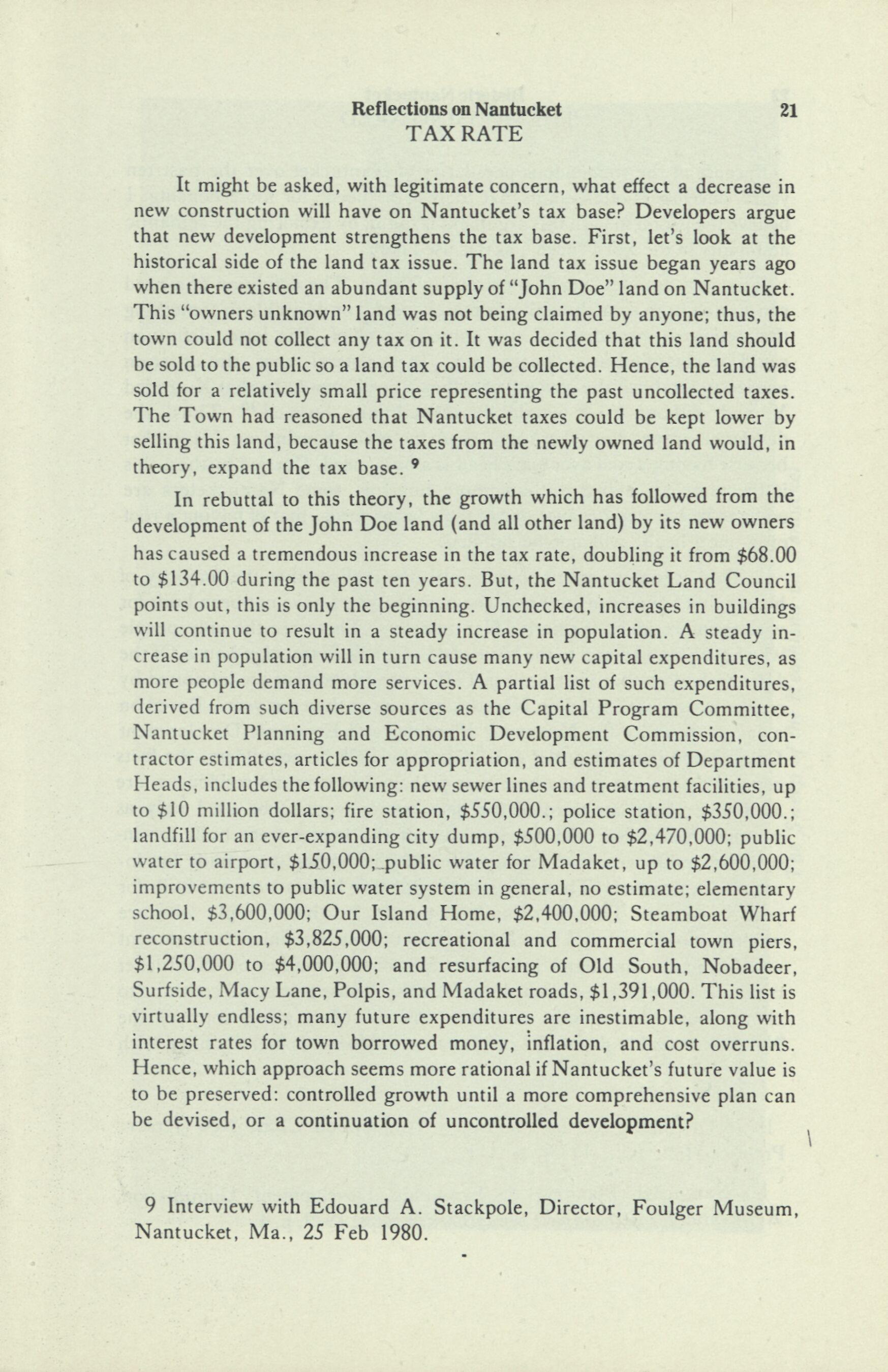
9 Interview with Edouard A. Stackpole, Director, Foulger Museum, Nantucket, Ma., 25 Feb 1980.
22 Historic Nantucket
THE HOUSING NEED
Because of the tremendous popularity of Nantucket over the past ten years, developers often claim that there is a "need" for more housing. I believe the problem with this argument is found by exploring the semantic ambiguity in the word "need", as it is used here.
The concept of a "need" is extremely elastic. The definition of a need can stretch from something that is merely useful or desirable to something that requires unconditional and immediate relief. The latter definition could be classified as a "basic need". In a general sense, the criterion needed to establish the concept of a "basic need" would be that X needed Y, and without Y, X would be substantially harmed.'0 Thus, the developer argues that there is a need for more housing on Nantucket because having a roof over one's head is a basic need. Carried further, this is the same as saying: without more housing, some Nantucketers are going to be harmed because one of their basic needs, that of having a roof over one's head, will not be fulfilled.
This argument seems sound until one realizes that the majority of houses that have been built over the past ten years have not been built for year-round residents or native Nantucketers. These are the only people , who have a valid claim to the basic need of a new Nantucket house.Of the 116 new houses that were built in 1978, only 5.6 percent are inhabited by residents who have lived on Nantucket for more than ten years. Based on a survey done by the Nantucket Planning and Economic Development Commission (hereafter, NP & EDC) of the 1978 homebuilders, the facts concerning the use of new homes as principal year-round residences, are as follows: only one-third of the new homes were to be used only as summer residences; and twenty-three of the homes were built for insummer residences: and twenty-three of the homes were built for investment purposes." Thus, the majority of new homes were not built for year-round use. They were built primarily for those people who are wealthy enough to buy a second home in a unique, but finite, environment away from the mainland bustle. If the housing market on Nantucket continues to be directed towards the wealthy, house prices will continue to climb above the already exorbitant prices. (Any given copy of the Nantucket weekly paper, The Inquirer and Mirror, is literally filled with

10 Joel Feinberg, Social Philosophy (Englewood Cliffs, New Jersey: Prentice-Hall, Inc., 1973), p. 111.
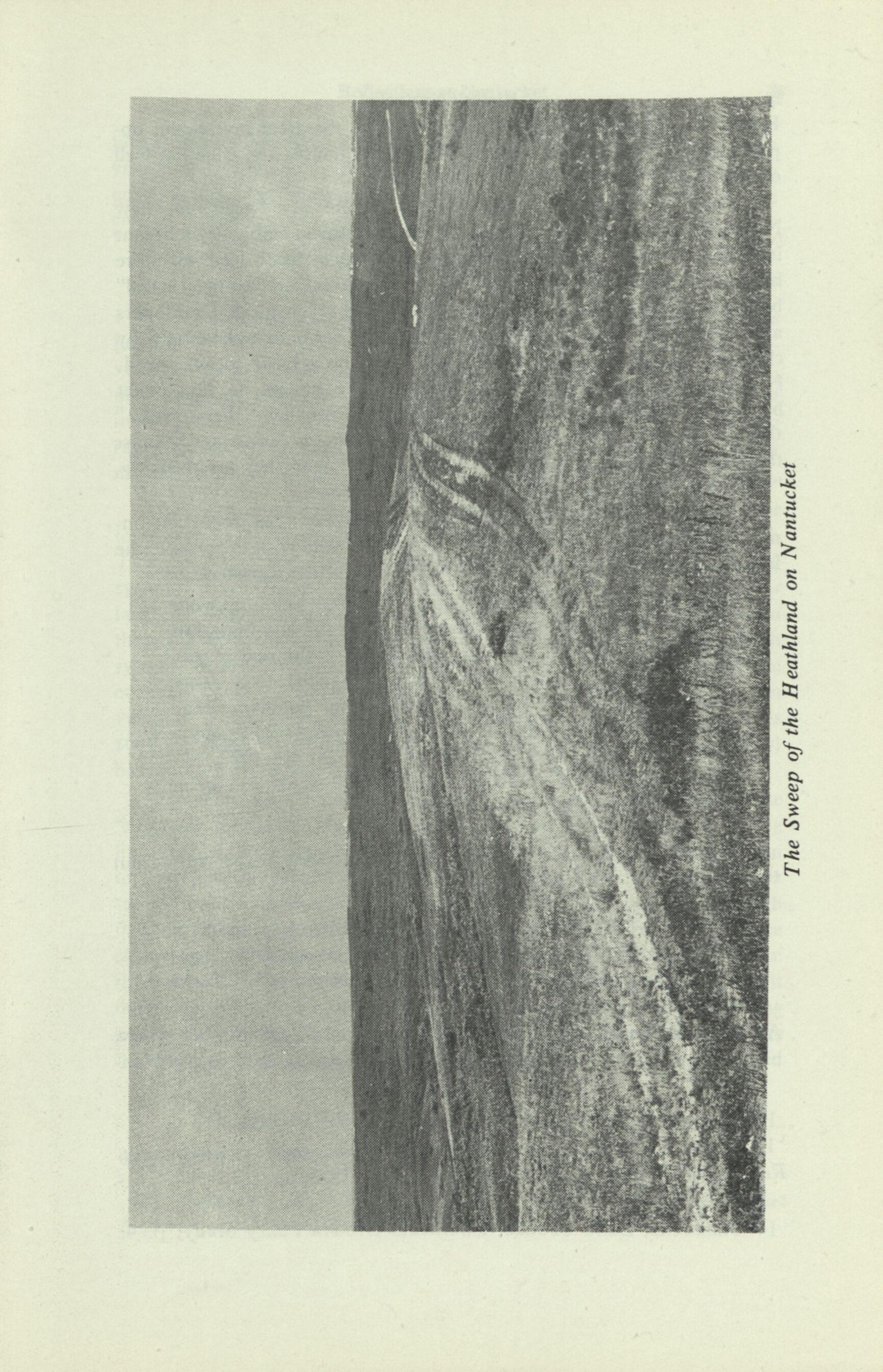
24 Historic Nantucket
Real Estate ads beckoning the elite to look at the great investment opportunites. The definite majority of Nantucket houses are valued at well over $100,000.00).
Thus, the developer's argument that there is a "need" for new Nantucket homes rests precariously on the semantical ambiguity inherent in the word "need". It is apparent that there is not a "basic need" for more housing on Nantucket. Rather, there is a demand or "artificial need" based purely on the salability of Nantucket land to outsiders. Developers and realtors are merely justifying their personal desire to make money by claiming that these desires are actually based on a basic societal need. Hence, when developers say, "We need more houses on Nantucket because Nantucketers have a basic need for a roof over their head, " they are actually saying "We desire more homes on Nantucket because there is a great demand for Nantucket houses"; and they are thinking, "More houses on Nantucket bring us more money."
Although the number of new houses each year is an important immediate planning consideration of those persons who wish to preserve the Island s intrinsic value, the NP & EDC raises a further consideration:
Also, it must be stressed that actual home building is only one side of the development isue-and to some the less important one. More urgent in many people's minds is the rate of subdivision of land which tends to have crucial long range ramifications for the Island's eventual total population and settlement pattern. Nantucket is currently being subdivided at the rate of about four hundred lots per year (in 1979, 557 building lots were created) almost all of which are being transferred to single ownership.'2
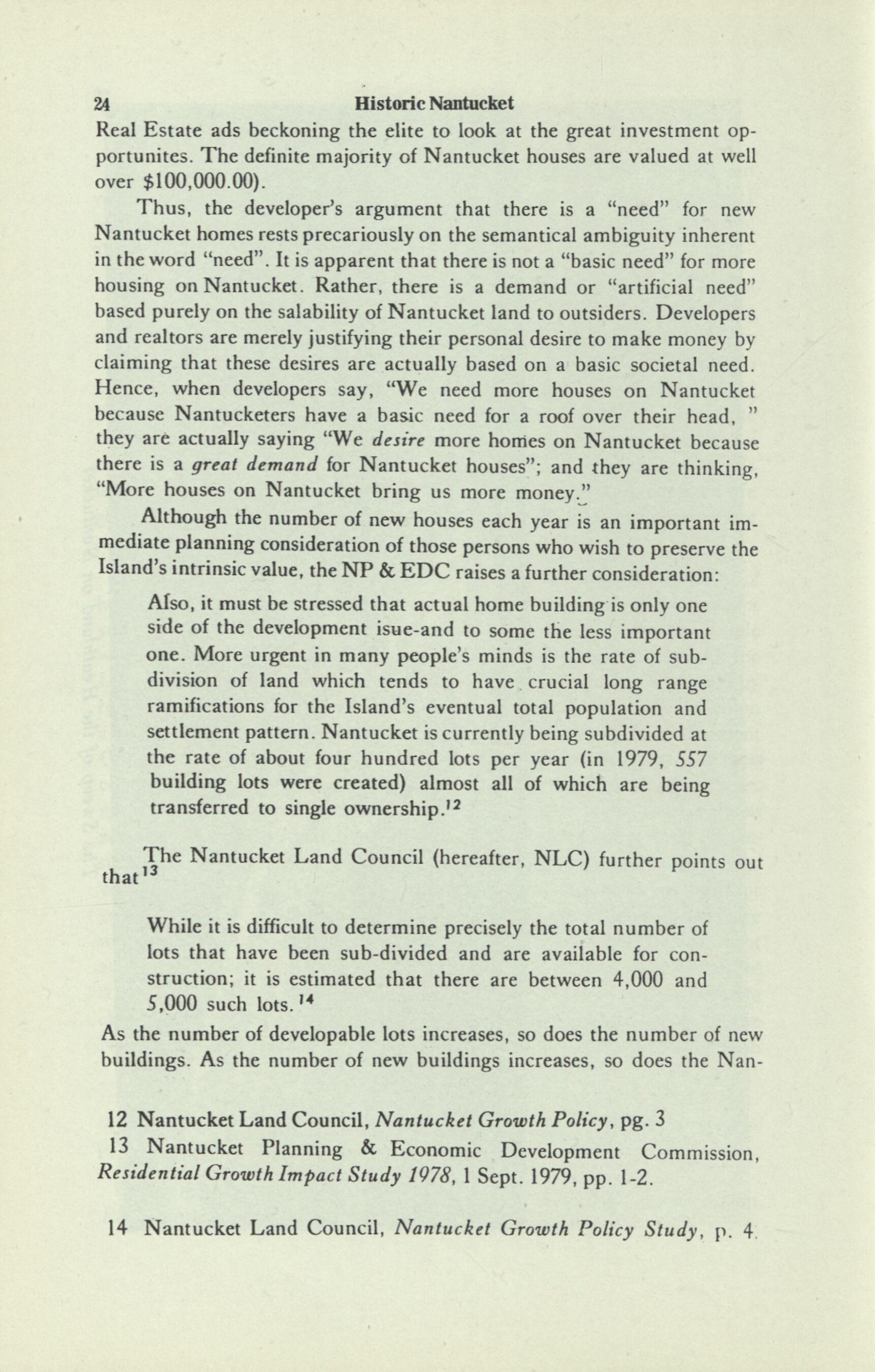
The Nantucket Land Council (hereafter, NLC) further points out that'3
While it is difficult to determine precisely the total number of lots that have been sub-divided and are available for construction; it is estimated that there are between 4,000 and 5,000 such lots.14 As the number of developable lots increases, so does the number of new buildings. As the number of new buildings increases, so does the Nan-
12 Nantucket Land Council, Nantucket Growth Policy, pg. 3 13 Nantucket Planning & Economic Development Commission, Residential Growth Impact Study 1978, 1 Sept. 1979, pp. 1-2.
tucket population. According to the NLC, at the 1979 rate, Nantucket's year-round population will double in sixteen years. If the rate continues to grow, as it has for the past four years, the population could double by the end • of the decade.15
POPULATION GROWTH
But, one might ask, what is so wrongwith the growth of Nantucket's population? Cybernetics, the science of control theory, provides a convenient way to view Nantucket's growth problem as a whole. In cybernetic language, a system, such as the growth of a human society, can exist in two general states: (1) a "transient state" in which the system is growing rapidly, and (2) a steady or "mature state", in which the system is maintained in an overall equilibrium for a relatively long period of time.
Every transient growth state, whether it pertains to the individual or to society, is under the influence of what is called "positive feedback". This idea means that each increase accelerates another increase. All living systems, in general, have an inherent tendency to grow. As systems grow larger and more complex, more feedback energy is required to maintain the intricate structure that has resulted. In Nantucket's societal growth system, positive feedback has almost exclusively taken the form of economic gain or financial increase. Because Nantucket land is so valuable (The latest estimate of Nantucket's real estate value is $660,000,000),'6econoinic gain (by selling this valuable land commo'dity) has become Nantucket's overriding blueprint for transient growth.
However, growth does not and cannot continue unrestricted because "negative feedback" control also comes into play, either by some limitation imposed by the external environment or by the action of an internal governor that brings about an orderly slowdown and establishes a set point at which growth in size stops. (This does not mean that growth in quality need stop). Human beings exhibit an example of the latter type of negative feedback control. Each individual has an internal governor in the form of a genetic code. This code first organizes growth, then slows it down and maintains an optimum state of maturity for a relatively long period of time. Quality maintenance replaces quantitative growth as the "strategy of survival" in the mature system.
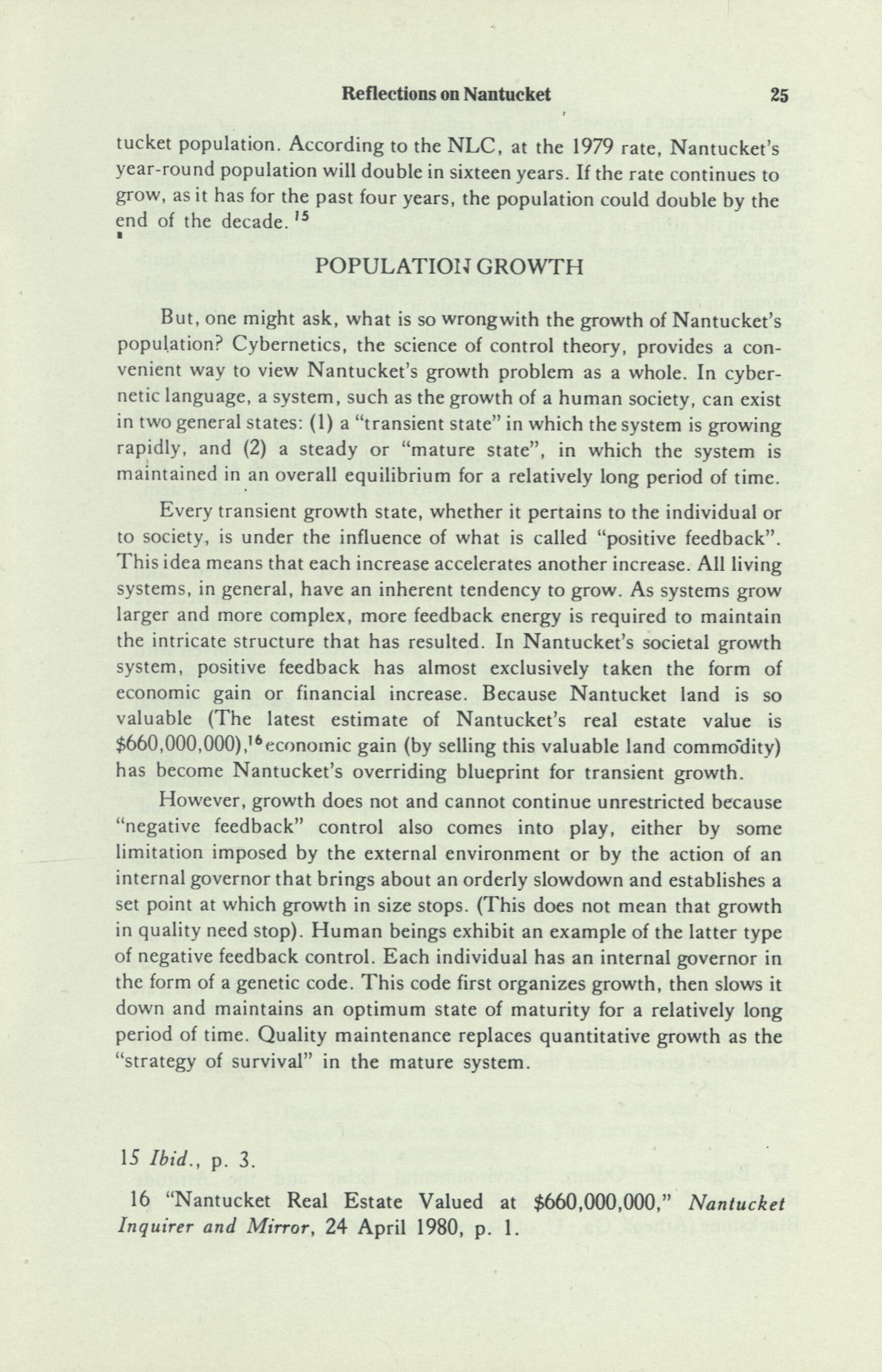
15 Ibid., p . 3.
16 "Nantucket Real Estate Valued at $660,000,000," Nantucket Inquirer and Mirror, 24 April 1980, p. 1.
26 Historic Nantucket
Nantucket's growth thus far reflects the former type of negative feedback control, i.e., some limitation is eventually implemented by the external environment. It takes on such forms as lower water quality, lower land-use quality, a loss in aesthetic potential,a lower cultural uniqueness, a loss in the ability to draw tourists, and so forth (incidentally, I feel these are a few of the elements that make up the Island's intrinsic value foundation). Sometimes, negative feedback of this sort can be detected early enough in the growth process to remedy it; most of the time, though, it continues unnoticed until it is completely overwhelming. Unfortunately, societies have no built-in "genetic code" that automatically monitors the transition from transient growth to qualitative maturity. Most Nantucketers simply don't realize that unless an internal governor is established that will slow down and set a standard by which growth should occur, the external environment's negative feedback system will overwhelm and eventually destroy not only the positive feedback system, but also Nantucket's total environment.
Thus, the problem with Nantucket's growth becomes this: Nantucket's external environmental constraints have not offered, and probably will not offer, adquate negative feedback about the destructive tendencies inherent in the positive feedback system until it is too late. So strong are the economic incentives of the positive feedback involved with increased commercial and residential growth, that overdevelopment seems inevitable if only external limits are used as a guide for societal growth.
We can all be proud of the fact that Nantucket has been able to grow and develop so well thus far while still retaining most of her pleasurable attributes. However, as saturation levels are approached, all the "good" attributes will lose their intrinsic qualities. Growth beyond the optimum becomes cancer. Nantucket needs time to decide just what the optimum state of maturity should be. Thus, there must be some sort of Nantucket governor implemented immediately if Nantucket's future transition is to be orderly and relatively free of cancerous intrusions caused by an uncontrolled growth system's tendency to "boom-and-bust". Nantucketers cannot continue to ignore the seemingly casual, but actually intricate relationship between them and their immediate environment. They must begin to think holistically about how all the ramifications involved in Nantucket's growth affect the homogeneous character of the island.'7

17 Eugene P. Odum, "Environmental Ethic and the Attitude Revolution," in Philosophy & Environmental Crisis, ed. William T. Blackstone (Athens, Ga.: U. of Georgia Press, 1974), pp. 13-14.




